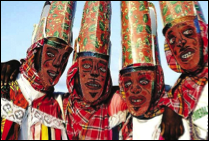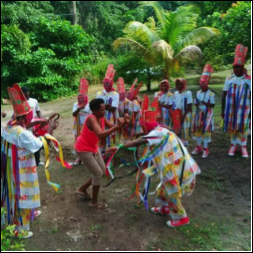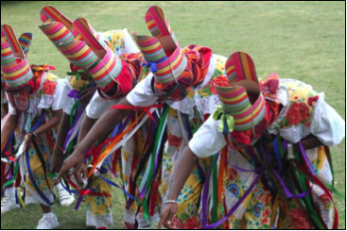Caribbean history and culture is woven together with influences from countries across the globe but the region is often seen as detached from the rest of the world. How much do we really know about the cluster of islands we call the Caribbean?
The Discovering the Caribbean series hopes to enlighten, surprise and inspire you with interesting stories and facts from across the Caribbean, so you too can appreciate and understand this unique part of the world.
We begin our journey of discovering the Caribbean with a gem of an island: the Caribbean’s ‘Emerald Isle’, Montserrat. A shared name is not the only connection between this volcanic Caribbean country and Ireland: the many Irish refugees that settled here in the early 17th century have heavily influenced Montserrat’s culture. This remains evident today with Irish names for many people and places throughout Montserrat, yet one of the most significant manifestations of this cultural connection is the beautifully mysterious masquerade dance.
Masquerade in and of itself is not  unique to Montserrat, drawing parallels to similar customs across the Caribbean, such as the jonkonnu festival held in various countries. However, the way in which the dance is performed in Montserrat is distinctive to this particular island.
unique to Montserrat, drawing parallels to similar customs across the Caribbean, such as the jonkonnu festival held in various countries. However, the way in which the dance is performed in Montserrat is distinctive to this particular island.
A fusion of African and European cultural influences, the dancers dress in bright and colourful garments adorned with assorted accessories including mirrors, whips, ribbons and the most crucial aspect of the attire, the mask itself. The mask is a tall headdress resembling a face with a ‘hat’ similar to a bishops mitre, like the one worn by Saint Patrick in some depictions.
The purpose of the masquerade dance is to pay respect to Montserrat’s ancestors, some of whom were slaves of Irish plantation owners. The dance is an expression of protest against the oppression of the slave-owners, which included the outlawing of slaves’ African customs of drumming, dance rituals, and folk traditions of worship and healing. Despite the efforts of the slave owners, these aspects of their identity were never truly lost: they survived throughout the years despite being banned from public practice.
As the slaves observed their masters at parties  and celebrations, either through the windows or while serving food at such events, they began to emulate the European folk dances they saw, in the way colonial subjects have often been reported to imitate the practices of those in power. Dancing was a form of entertainment for these slaves, mocking their owners with parodies and imitations, but it was also an important means of cultural communication. For example, the dances would often refer to malevolent ‘jumbie’ spirits, ghostly beings that control those who do evil and remind others to do good, though jumbie dances were also performed to help cure diseases, exorcise curses or discover guilt. Throughout these dances, the slaves wore masks to disguise their true identity and escape punishment at the hands of their masters.
and celebrations, either through the windows or while serving food at such events, they began to emulate the European folk dances they saw, in the way colonial subjects have often been reported to imitate the practices of those in power. Dancing was a form of entertainment for these slaves, mocking their owners with parodies and imitations, but it was also an important means of cultural communication. For example, the dances would often refer to malevolent ‘jumbie’ spirits, ghostly beings that control those who do evil and remind others to do good, though jumbie dances were also performed to help cure diseases, exorcise curses or discover guilt. Throughout these dances, the slaves wore masks to disguise their true identity and escape punishment at the hands of their masters.
Today the Masqueraders incorporate many symbolic elements in their performances. They wear their masks of course, but every other aspect of their attire also has a vital role in paying homage to their ancestors. Though the precise meaning behind many of these features is not entirely clear, the whip represents how the masters used to control the slaves, with the dancer holding the whip controlling the other dance movements, while the ribbons are said to symbolise freedom, flying openly through the air.
 Even the music reveals a distinct cultural fusion: the fiddle and fife are of European origin while the drums, maracas and other percussion instruments are of African and Latin American origin.
Even the music reveals a distinct cultural fusion: the fiddle and fife are of European origin while the drums, maracas and other percussion instruments are of African and Latin American origin.
Furthermore, the performers’ dance itself is a mix of these various traditions. Western movements are incorporated, namely the Irish ‘jig’, the heel and toe polka, and the quadrilles, similar to square dancing, but these European folk steps are blended with African traditional dancing and festive dress to create new art forms for a variety of celebrations, including the Christmas break from plantation work.
There is no better time to see this display than the week of Saint Patrick’s Day, when the people of Montserrat celebrate not only the life of St. Patrick but also commemorate an historic slave revolt that took place on the St. Patrick’s Day of 1768. The slaves had hatched the plan for an island-wide assault while the slave-owners were celebrating the holiday period. House slaves were to seize all weapons from Government House, and field slaves storm the building with rocks, farm tools and homemade swords. Despite the three to one numerical advantage of the slaves, the plot had been leaked and the local authorities were prepared for the attack. Though the rebellion failed and nine slaves were hanged in punishment, Montserratians today rightly see fit to commemorate their bravery in the face of injustice.
The masquerade dance remains a vivid reminder of the complex history of Montserrat, as different cultures converged and clashed, but in the process created new and profound expressions that are treasured as part of the unique Montserratian heritage.
Author: Jerome Harewood.
6th January 2015.
